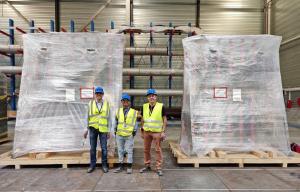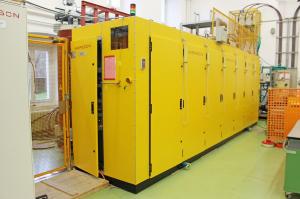First power supply delivered
Turning the key in your car causes an electrical current to be sent from your battery to your car's engine, where a small electrode (or "spark plug") generates an electrical discharge to ignite the fuel and make your engine "go." ITER has an equivalent—except the spark to make the plasma "go" is created by sending high-power microwaves (equivalent to 6,000 kitchen microwave ovens) into the vacuum vessel. All of this power creates the initial flash—like the spark plug in your car engine—that initiates each plasma pulse.
This is achieved by placing nearly 100 smaller power supplies in series, and switching on and off each supply to provide a controlled ramp-up of the voltage from 0 to 55 kV in roughly 100 milliseconds, then maintain a stable voltage for up to one hour. More rapid control is possible: for example, the power supplies can drop to 0 V in 10 microseconds in the event of a fault in either the gyrotron or downstream toward the machine. These smaller power supplies are made from solid-state transistors that operate with greater than 97% electrical efficiency, with the aim being to maximize the power given to the plasma.



